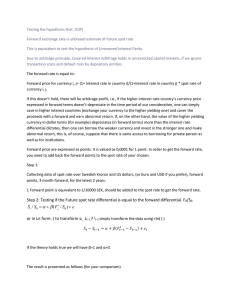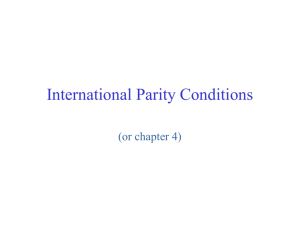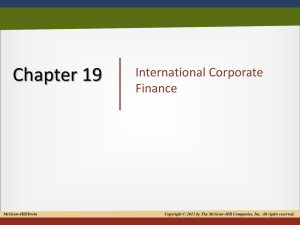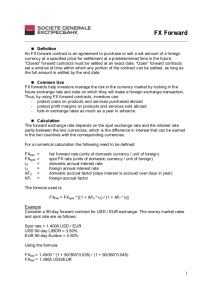Forward Rates
advertisement
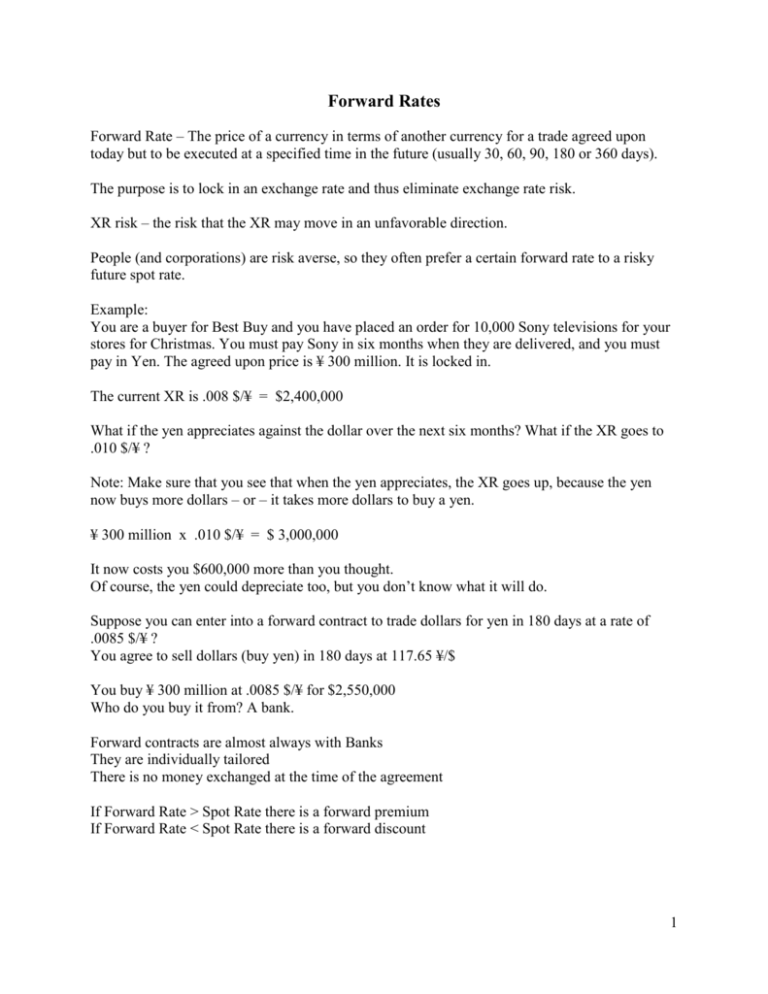
Forward Rates Forward Rate – The price of a currency in terms of another currency for a trade agreed upon today but to be executed at a specified time in the future (usually 30, 60, 90, 180 or 360 days). The purpose is to lock in an exchange rate and thus eliminate exchange rate risk. XR risk – the risk that the XR may move in an unfavorable direction. People (and corporations) are risk averse, so they often prefer a certain forward rate to a risky future spot rate. Example: You are a buyer for Best Buy and you have placed an order for 10,000 Sony televisions for your stores for Christmas. You must pay Sony in six months when they are delivered, and you must pay in Yen. The agreed upon price is ¥ 300 million. It is locked in. The current XR is .008 $/¥ = $2,400,000 What if the yen appreciates against the dollar over the next six months? What if the XR goes to .010 $/¥ ? Note: Make sure that you see that when the yen appreciates, the XR goes up, because the yen now buys more dollars – or – it takes more dollars to buy a yen. ¥ 300 million x .010 $/¥ = $ 3,000,000 It now costs you $600,000 more than you thought. Of course, the yen could depreciate too, but you don’t know what it will do. Suppose you can enter into a forward contract to trade dollars for yen in 180 days at a rate of .0085 $/¥ ? You agree to sell dollars (buy yen) in 180 days at 117.65 ¥/$ You buy ¥ 300 million at .0085 $/¥ for $2,550,000 Who do you buy it from? A bank. Forward contracts are almost always with Banks They are individually tailored There is no money exchanged at the time of the agreement If Forward Rate > Spot Rate there is a forward premium If Forward Rate < Spot Rate there is a forward discount 1 In our example, Spot Rate = .0080 $/¥ Forward Rate = .0085 $/¥ There is a forward premium since Forward > Spot Premiums and discounts are computed on an annual basis. For Currency in Denominator: Premium (discount) = Forward Rate – Spot Rate x 360 Spot Rate Length of Forward Contract (in days) = .0085 - .0080 x 360 .0080 180 = .125 = 12.5% For Currency in Numerator: Premium (discount) = Spot Rate – Forward Rate x 360 Forward Rate Length of Forward Contract (in days) Note that a negative value would be a discount. What determines the forward rate? If you are a bank, and you engage in trades in both directions, how will you set the forward rate? Note: The forward rate is not the same thing as the future spot rate. You will want the forward rate to be close to what you expect the spot rate to be at that time. Some thus feel that the forward rate is an unbiased predictor of the expected future spot rate – but it is not. Meaning you can’t look at today’s forward rate and say that in 6 months I’ll exchange currency on the spot market at that rate. So how exactly is the forward rate determined? An example may help. Suppose the spot rate for CD (Canadian dollars) is .73 $/CD The 6 mo. forward rate for CD is also .73 $/CD The U.S. interest rate is 5% (per year) The Canadian interest rate is 5.5% What can you do? 2 1. 2. 3. 4. Borrow $100 at 5% in the U.S. Convert it to CD: $100 .73 $/CD = CD 136.99 Invest it in Canada at 5.5% for six months Enter into a forward contract to sell CD 140.76 at .73 $/CD in six months Six Months from now: 1. Your CD 136.99 has grown to CD 140.76 136.99 (1 + .055/2) = 140.76 2. Convert the CD to $ thru your forward contract CD140.76 x .73 $/CD = $102.75 3. Pay off your debt. $100 (1 + .05/2) = $102.50 4. You have $0.25 profit You made $.025 in 6 months. But notice that you didn’t need any investment – just the ability to borrow $100. You can make $25,000 if you borrow $10 million and $250,000 if you borrow $100 million. This is arbitrage – making a guaranteed profit with no upfront investment. This condition will not hold. As everyone buys CD in the spot market, the CD appreciates which increases the XR. As everyone sells CD in the forward market, the forward rate goes down. In equilibrium, the following relationship must hold: (1 + i) = F(0,1) (1 + i*) S(0) where i = domestic int. rate and i* = foreign int. rate and we are using direct quotes for the forward and spot rates In our example: F = .73 $/CD x (1 + .05/2) (1 + .055/2) = .728224 $/CD So CD should be selling forward at a discount. If this is the forward rate, and you try to arbitrage, when you convert back your CD to $, you will get CD 140.76 x .728224 = $102.50 which will just pay off the U.S. loan This is called Interest Rate Parity. The country with the higher interest rates will have its currency selling forward at a discount. If Interest Rate Parity exists, covered interest arbitrage will not be possible. The above example was covered because we used the forward rate to “cover” our currency conversion in six months – no risk. 3 Covered interest arbitrage involves borrowing in the home currency, converting it to the foreign currency, and investing it at a higher interest rate, taking out a forward contract to convert it back to the home currency at maturity, paying off the home loan and ending up with a profit. Transaction costs, risk differences and taxes mean that the forward rate doesn’t have to exactly equal the spot times the interest rate ratio, but it must be close enough so that an arbitrage profit cannot be made. 4
